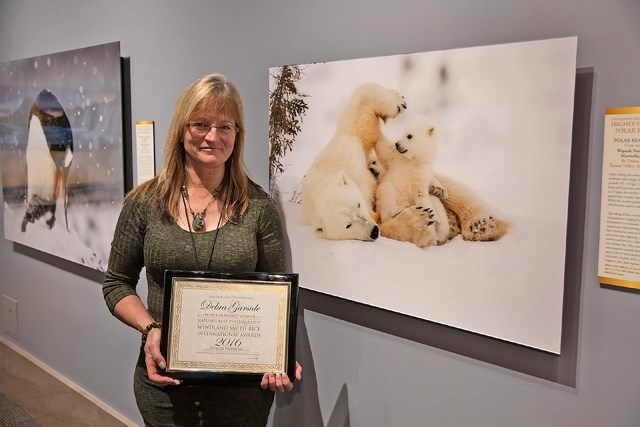In temperatures colder than she ever imagined possible, Debra Garside lay on the frozen tundra snapping photo after photo of a polar bear and her young cubs frolicking in the snow.
Dressed in six layers of clothing, the Longview photographer was determined to capture the perfect shot in northern Manitoba’s Wapusk National Park last February despite numb fingers and frostbite.
“I’ve struggled with pouring rain and wind and cold but nothing, nothing compares with standing around or laying on the snow all day in -35C to -55C conditions,” she said. “It’s unbelievably difficult. You are fighting frostbite and your gear doesn’t want to work. Great images seem to be proportionate to how much suffering the photographer has to endure.”
The hard work was well worth it. One of Garside’s heartwarming images won the prestigious Nature’s Best Photography Award.
“It’s kind of like the Golden Globe Awards of nature photography,” she said. “It’s one of the top nature photography contests in the world so getting into it is really quite an honour.”
The image is among 82 hanging in the Smithsonian National Museum of Natural History’s Windland Smith Rice International Awards Smithsonian Exhibition, where it will be on display for a year.
“It was epic for me to stand on the front steps of the Smithsonian Institute in Washington D.C.,” she said. “They have eight million people go through there every year. It’s such a great honour. You grow up knowing about the Smithsonian and the conservation initiatives. To get to be a part of that is pretty amazing.”
Garside received the award during a ceremony last month.
This is the second time she’s entered the contest, where tens of thousands of photographs taken by photographers from around the world are judged by a jury of professionals.
Her first submission was of wild horses on Sable Island in the Maritimes a couple of years ago. She didn’t win an award, but her photography was featured in Nature’s Best Photography Magazine.
This year Garside went to even greater lengths to capture a rare glimpse of nature.
“I’ve always wanted to photograph polar bears,” she said. “I’ve always wanted to go to this particular place. It’s very expensive and they have a three-year waiting list.”
With no polar bears in sight the first six days of the trip, Garside booked another four days hoping for just a glimpse of a family of bears.
“There’s people that will spend two weeks there and never see a bear,” she said. “The timing is very specific. The lodge is only open for six weeks. It’s a crapshoot during that timeframe when the bears come out of their dens. I got lucky.”
Garside got lucky on the seventh day when a mother bear and two cubs emerged from a den.
“The moms and the new cubs have this routine where they come out of the den, play for a little while, nurse, go to sleep and you don’t know how long they are going to sleep - it might be 10 minutes or two hours,” she said. “You are just waiting for that perfect shot where the behaviour is interesting and it’s cute and somehow also works compositionally with the lighting and everything else.”
This opportunity isn’t for the faint of heart.
Garside said she was among a small few of about two dozen who braved the elements from 9 a.m. until about 6 p.m. The others took refuge in the warm van.
“Most people will not spend six, seven hours in that temperature,” she said. “You know as soon as you go somewhere to warm up that’s when the good behaviour happens. You don’t even take the chance. You spend all that money and you go through great lengths to be able to do this.”
On the two days polar bears emerged from their dens, Garside was ready and snapped around 3,000 pictures.
“When things start to happen you are shooting 10 frames per second,” she said. “You are looking for just the nuance, the light in the animals’ eyes, the position. You look for that one shot that’s particularly interesting and has the right light. I probably got 30 images that I’m really happy with.”
She credits her father for the opportunity to shoot the polar bear families. A friend of Garside’s booked the trip years prior, but it was an expense Garside couldn’t afford until her father passed away and left her some money.
“I phoned up the lodge and said, ‘If you have a last minute cancellation I would really love to go,’” she said. “They said that never happens. Literally 10 minutes later they called me back and said, ‘This is weird, we just got a cancellation. If you can be here in two days you can have that spot.’”
Garside also credits her father for her love of the outdoors.
“He was my inspiration always when it came to the outdoors,” she said. “I spent a lot of time as a kid camping, hunting and fishing.”
Garside paid a tearful tribute to her father while accepting the award.
“I thanked my dad because it was because of his passing that I was able to do it,” she said. “That was the big thing for me.”
With hopes of capturing more polar bear images, Garside is heading to Norway in June to photograph male polar bears hunting.
Those images and the others she’s captured of grizzly bears, black bears and kermode bears on the British Columbia coast will appear in a book she plans to publish that will also include journal entries of her experiences.
Some of Garside’s polar bear images are available for viewing at the Garside Wilson Gallery in Longview and at debragarside.ca




